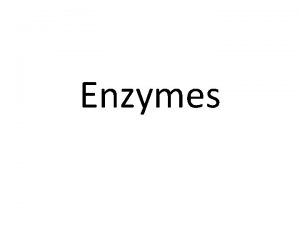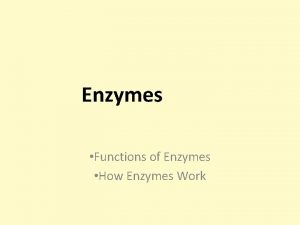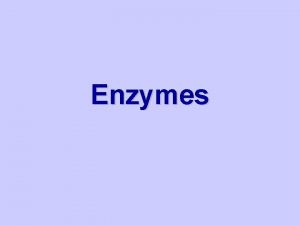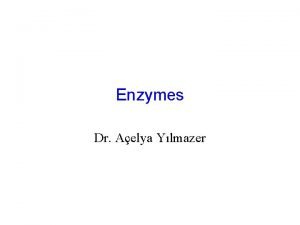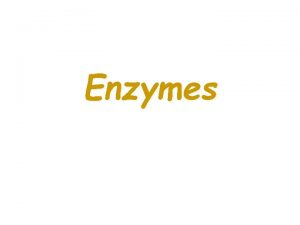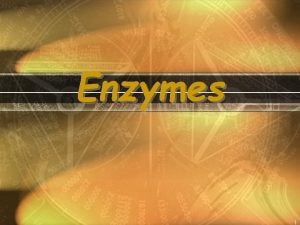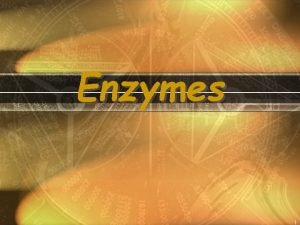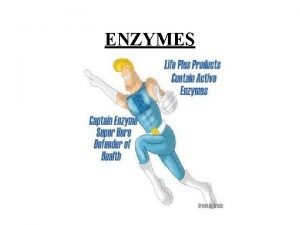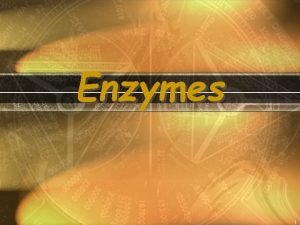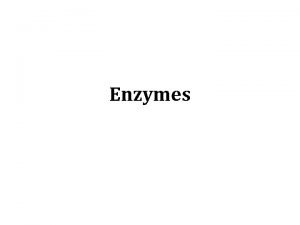Enzymes What are they good for Essential Questions















- Slides: 15

Enzymes! (What are they good for? ) Essential Questions: What is an Enzyme? How do they work? What are the properties of Enzymes? How do they maintain Homeostasis for the body?

What are Enzymes? • Enzymes are proteins which act as biological catalysts. – A catalyst is a substance that starts or speeds up a chemical reaction without itself being affected. – It lowers the activation energy required for the reaction to take place. • Their subunits are amino acids. • Enzymes are used by cells to trigger and control chemical reactions. • Without enzymes, several reactions in cells would never occur or happen too slowly to be useful.

Wait, What is a Chemical Reaction? • It is the process of changing one set of chemicals (reactants) into another set of chemicals (products) by rearranging the atoms. • Reactants’ bonds are broken and new ones are formed in the products. 2 H 2 + O 2 → 2 H 2 O

Wait, What is activation energy? • Activation energy is the amount of energy needed to start a chemical reaction.

Ok, so How do Enzymes Work? • Enzymes enable molecules called reactants to undergo a chemical reaction with specific substrates and form new substances called products. • Energy can be exothermic (release heat, energy) or endothermic (require heat, energy) • Enzymes speed up chemical reactions that take place in cells. – They lower activation energy • They catalyze specific substrates into products and leave the enzyme unchanged and ready to catalyze the next reaction.

What is a substrate? • Enzymes bind to molecules called substrate(s). • The(se) substrate(s) are the reactants that are catalyzed by the enzyme. – Example: Typically something we ingest that needs to be broken down further for use by the body like Lactose from Cow’s milk. (Done by Lactase) Enzyme Animation: http: //www. youtube. com/watch? v=V 4 OPO 6 JQLOE

Enzyme Action: Locks & Keys • Enzymes provide an area where reactants can be brought together to react. • The site on the enzyme where the substrates bind is called the active site. • The reactants are called the substrate(s). • The substrate(s) enters the active site which becomes the enzymesubstrate complex. • The shape of an enzyme is so specific that generally one enzyme will work for one substrate(s). The fit is so exact that the active site and substrates are compared to a “lock and key”. http: //www. youtube. com/watch? v=V 4 OPO 6 JQLOE

Enzymes: Catch & Release • After the enzyme has complexed with the substrate, the change molecule is released (called a product) to be used by the body. • Each protein has a specific shape, therefore enzymes bind to substrates based on shape. – the substrates are based on the complementary shape of their specific enzyme. Recall: Based upon what you know about proteins, what is it about enzymes • Since only the substrate changes that allows them to be so during the reaction, the enzyme specific to only one can be reused again and again. substrate? Because of the different combination of the 20 essential amino acids, there are thousands! http: //en. wikipedia. org/wiki/List_of_enzymes

Induce Fit Hypothesis • Enzymes can change shape slightly to fit the substrate a little better (like a hand in glove). Induced Fit Animation: http: //www. youtube. com/watch? v=ybahz. Sj. Up. B 0&feature=Play. List&p=C 846 C 10 E 855 E 64 E 1&index=12&playnext=2&playnext_from=PL

Enzymes can be turned on and off. • Enzymes work best at specific temperatures and p. H. • Heating and the wrong p. H can change the enzyme shape affecting the binding of the substrate to the enzyme. – Recall: What is the term for heating of enzymes called? denature • Ergo, enzymes in our body work best at 37°C (98. 6°F) and at a p. H between 6. 5 to 7. 5. • Also, most cells contain proteins that turn enzymes on or off during critical stages of development. What other factors control this enzyme? Co factors l, r, and x

Enzyme Characteristics: Review • Remember, Enzymes are catalytic proteins. 1. Speed up reaction rate but do not change the reaction. 2. Enzymes are very specific. 3. Enzymes work like locks & keys. – Example: Lactose and Lactase 4. Enzymes are unchanged. 5. Enzymes are sensitive to changes in temperature and p. H. 6. The suffix –ase means it is an enzyme. – Example: lactase, sucrase cellulase, maltase…

Your Turn! The Effect of Catalase Question/Problem: What are the effects of p. H on enzymatic reactions? Observations/Control: Watch the following clip up to 0: 35. http: //www. youtube. com/watch? v=bq. Esv. Nhv. N 8 E What initial observations can you make about the effect of this enzyme? Catalase is an enzyme that breaks down hydrogen peroxide. (H 2 O 2 → H 2 O + O 2) The presence of bubbling (gas) makes you know it is working. Hypothesis: What effect do you think that p. H will have on the action of catalase in potatoes at p. H of 4, 7 and 9? At what p. H will it work the best, and which p. H will it work the worst? Explain why in your response. Experiment: Watch the remainder of the clip. Take note of the anemometer reading in red. We’ll watch the clip again to make sure…freeze at 1: 30.

Results and Conclusions Results: Was your hypothesis supported or rejected? Conclusions: 1. What is catalase used for in the body? It is a digestive enzyme that occurs in plant and animal tissues to get rid of excess hydrogen peroxide (H 202) 2. Why was an anemometer used? Measures the Oxygen gas given off as the product of the enzymatic reaction of catalase. 3. Why do you think that catalase worked best at a p. H of 7? That’s the optimum condition (p. H) in living things (neutral). 4. What do you think happened to the enzyme at the extremes of p. H? It likely partially denatured (affected its shape) and didn’t function as well. 5. Hydrogen peroxide is a harmful by-product of many normal metabolic processes. What do you think would happen if catalase was not functioning properly? Cells would be damaged and die, harming the organism.


Enzyme Animation • http: //www. kscience. co. uk/animations/anim_ 2. htm
 Mikael ferm
Mikael ferm Essential non essential fatty acids
Essential non essential fatty acids Good thoughts good words good deeds
Good thoughts good words good deeds Hello teacher good afternoon
Hello teacher good afternoon Cómo se dice buenas tardes
Cómo se dice buenas tardes You are good when there's nothing good in me
You are good when there's nothing good in me Good afternoon me
Good afternoon me Fspos
Fspos Typiska novell drag
Typiska novell drag Nationell inriktning för artificiell intelligens
Nationell inriktning för artificiell intelligens Vad står k.r.å.k.a.n för
Vad står k.r.å.k.a.n för Shingelfrisyren
Shingelfrisyren En lathund för arbete med kontinuitetshantering
En lathund för arbete med kontinuitetshantering Kassaregister ideell förening
Kassaregister ideell förening Tidbok
Tidbok Anatomi organ reproduksi
Anatomi organ reproduksi

















